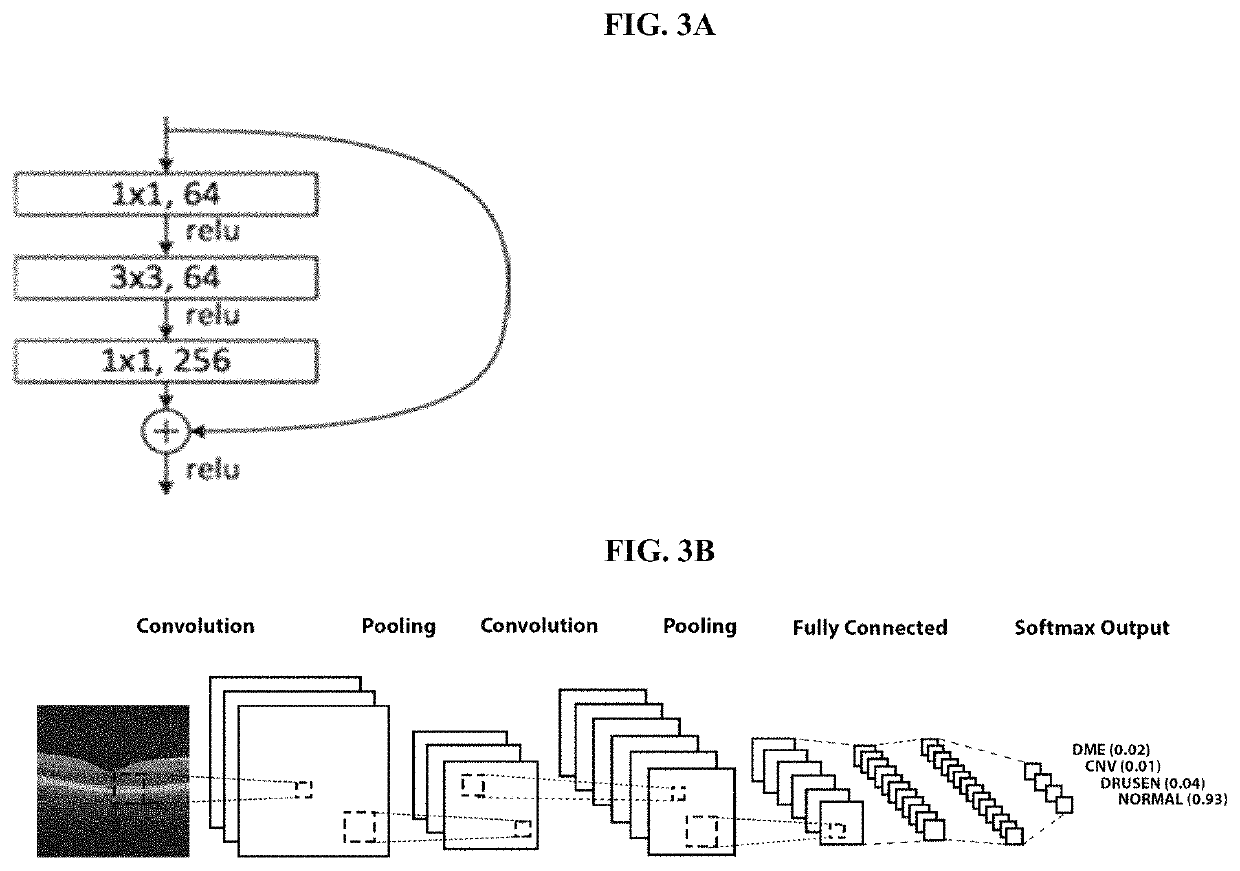Deep learning-based diagnosis and referral of ophthalmic diseases and disorders
a deep learning and diagnosis technology, applied in the field of deep learning-based diagnosis and referral of ophthalmic diseases and disorders, can solve the problems of inability to adequately perform image analysis without significant human intervention, creation and refinement of multiple classifiers, and inability to adequately perform so as to achieve the effect of effective image analysis and/or diagnosis, less computational power, and improved speed, efficiency and computational power
- Summary
- Abstract
- Description
- Claims
- Application Information
AI Technical Summary
Benefits of technology
Problems solved by technology
Method used
Image
Examples
example 1
[0144]A total of 207,130 OCT images were initially obtained of which 108,312 images (37,206 with CNV, 11,349 with DME, 8617 with drusen, and 51,140 normal) from 4,686 patients were used to train the AI system. The trained model (e.g. trained machine learning algorithm or classifier) was then tested with 1,000 images (250 from each category—CNV, DME, drusen, and normal) from 633 patients.
[0145]After 100 epochs (iterations through the entire dataset), the training was stopped due to the absence of further improvement in both accuracy (FIG. 4A) and cross-entropy loss (FIG. 4B).
[0146]In a multi-class comparison between CNV, DME, drusen, and normal, an accuracy of 96.6% (FIG. 4), with a sensitivity of 97.8%, a specificity of 97.4%, and a weighted error of 6.6% were achieved. ROC curves were generated to evaluate the model's ability to distinguish “urgent referrals” (defined as CNV or DME) from normal and drusen exams. The area under the ROC curve was 99.9% (FIG. 4).
[0147]Another “limited...
example 2
[0151]An independent test set of 1000 images from 633 patients was used to compare the AI network's referral decisions (e.g. using the AI from Example 1) with the decisions made by human experts. Six experts with significant clinical experience in an academic ophthalmology center were instructed to make a referral decision on each test patient using only the patient's OCT images. Performance on the clinically most important decision of distinguishing patients needing “urgent referral” (those with CNV or DME) compared to normal patients is displayed as a ROC curve, and this performance was comparable between the AI system and the human experts (FIG. 4A).
[0152]Having established a standard expert performance evaluation system, the potential impact of patient referral decisions between the network and human experts was compared. The sensitivities and specificities of the experts were plotted on the ROC curve of the trained model, and the differences in diagnostic performance, measured ...
example 3
Summary
[0168]Despite the overall effectiveness of cataract surgery in improving vision, a significant number of patients still have decreased vision after cataract extraction. Understanding the underlying etiologies of persistent post-operative vision impairment is of great importance. In China, myopia is the number one cause of visual impairment, with nearly half of population being affected. Despite its prevalence, its impact on the visual outcomes after cataract surgery remains unclear. In this study, a prospective trial was conducted on the effects of high myopia on visual outcomes after cataract surgery in 1,005 patients with high myopia patients (axial length≥26 mm). Multi-variable analysis was conducted to identify factors influencing visual outcomes. Macular sensitivity images were then used to train a deep learning model for predicting post-operative visual acuity. This model demonstrated an accuracy of over 90% in the validation set, suggesting the high utility of artifici...
PUM
 Login to View More
Login to View More Abstract
Description
Claims
Application Information
 Login to View More
Login to View More - R&D
- Intellectual Property
- Life Sciences
- Materials
- Tech Scout
- Unparalleled Data Quality
- Higher Quality Content
- 60% Fewer Hallucinations
Browse by: Latest US Patents, China's latest patents, Technical Efficacy Thesaurus, Application Domain, Technology Topic, Popular Technical Reports.
© 2025 PatSnap. All rights reserved.Legal|Privacy policy|Modern Slavery Act Transparency Statement|Sitemap|About US| Contact US: help@patsnap.com



